
Edward Winter

Little regarding Charles Jaffe seems straightforward, and Jeremy Gaige’s excellent book Chess Personalia wisely left Jaffe’s birth-date as the vague ‘circa 1879’. As Gaige wrote on page 45 of an earlier work, A Catalog of U.S.A. Chess Personalia (Worcester, 1980):
‘But consider the case of Charles Jaffe: just when was he born?
- 1879 in Dubrovna, according Jaffe’s Chess Primer, page 5.
- 1883, according to Chess Review, March 1933, page 2.
- about 1876, in Dubrozno, according to his obituary in The New York Times of 12 July 1941, which said he died at age 65.
- about 1881, according to The Day and The Jewish Journal (both New York Yiddish newspapers), which said he died at age 60.
- 10 December 1887, in Dubrovno, according to the Biographical Dictionary of Modern Yiddish Literature, volume 4, columns 203-204.
- about 1878, according to the tournament book of Havana, 1913, which gave his age at that time as 35.’
On page 3 of the same booklet Gaige noted:
‘… the field of chess history comes well strewn with pitfalls – such as giving 1883 as the year for Charles Jaffe’s birth because Chess Review in 1933 picked up a report on a 50th birthday party for Charles Jaffee (a man with no relation to chess) and grafted that onto Charles Jaffe.’

C.N. 797 quoted a brief passage from Jaffe’s Chess Primer (New York, 1937), but a more detailed scrutiny of that spectacularly awful book is overdue.
It opened with an unsigned ‘Biography’, reproduced below with our comments in square brackets:
‘Charles Jaffe was born in Dubrovna, State of Mogilev on the Dneiper, Russia in 1879. While he attended the Russian and Hebrew schools, he displayed unmistakable signs of native chess talent.
At the age of 17 he came to America. He worked as a weaver in the silk mills of New York, New Jersey, and Pennsylvania until he reached the 31st year of his life. In 1910 he became prominent in chess circles both as a player and writer. At the First National American Chess Tournament in 1911 he shared third prize with Oscar Chajes, one-half point behind Capablanca [sic – Marshall won the tournament ahead of the Cuban]. In the same year he won the brilliancy prize [sic - one of 12 brilliancy prizes] and master title [sic – he finished joint bottom (equal 23rd)] at Carlsbaad [sic]. In 1913 at the Second National American Chess Tournament, he won the third prize defeating Capablanca, Janovski [sic], Chajes, Kupchik; but drawing with Marshall who was then US champion. In 1915 he won the New York State Championship [sic - Kupchik won]. He won matches against J. Ohrbach, champion of Paris [sic - presumably Arnold Aurbach - see La Stratégie, October 1911, page 372], Jacques Mieses, champion of Germany [sic], and Oscar Chajes, Western States champion. He has an even record against Jose Capablanca, winning two [sic] and losing two [sic]. In single games he has defeated such eminent players as Dr Emanuel Lasker, Frank J. Marshall, D. Janowski, J. Showalter and a host of others.
Charles Jaffe’s career has been both remarkable and tragic. At the very height of his fame his progress was intercepted by Jose Capablanca. At the Havana Tournament of 1913 Mr Capablanca stated to the press that since Jaffe had come to Cuba for the sole purpose of helping Marshall win, he would never again play in a tournament where Jaffe was entered as a contestant. It is certainly deplorable that Messrs Cassel and Helms, the American chess correspondents, not only believed these charges but also aided Capablanca by successfully keeping Jaffe out of all those American Tournaments in which they had influence. It might be noted that the great Dr Emanuel Lasker was driven from the US by very much the same tactics. He was barred from the New York Sextet Master Tournament of 1927.
Charles Jaffe’s knowledge of the game is unsurpassed by anyone. As an expert in the openings there is no one in the world who is his superior. In this field he has made many useful and ingenious contributions. The book is timely and necessary, for even the great masters will find new and unorthodox things of value.’
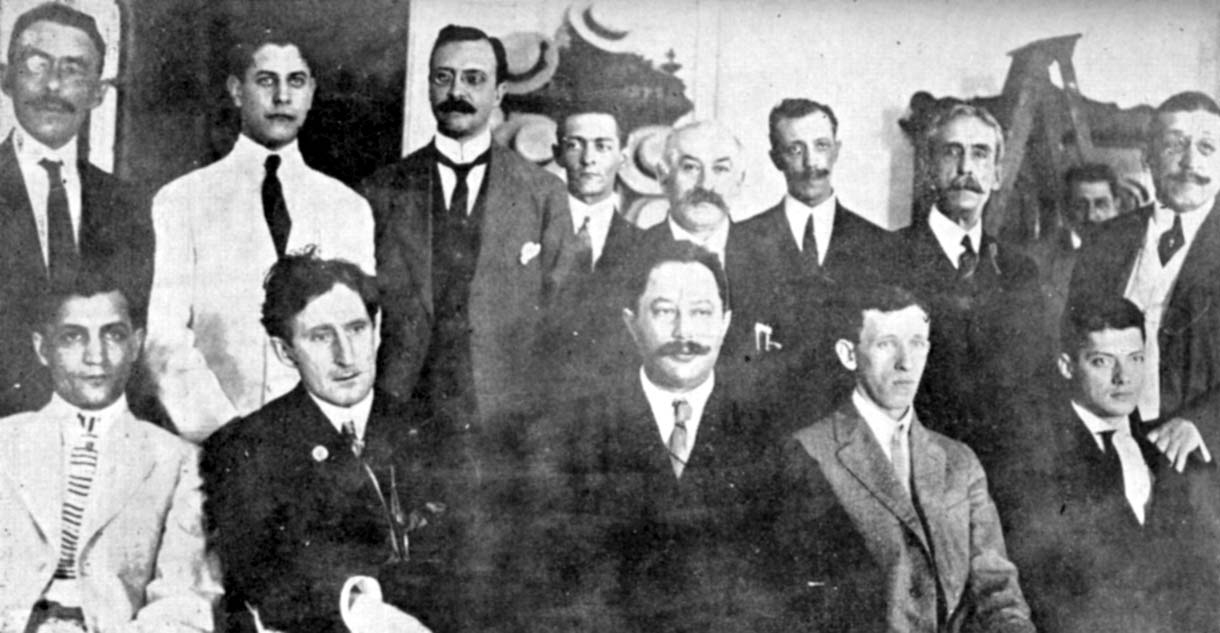
Havana, 1913. Anti-clockwise from bottom left: C. Jaffe, F.J. Marshall, O. Chajes, A. Kupchik, R. Blanco, L. Paredes, A. Ponce, E. Corzo, H. Cassel, S. Capablanca, J. Corzo, J.R. Capablanca, D. Janowsky.
The following page of Jaffe’s Chess Primer had a Foreword by Reshevsky. It too emphasized Jaffe’s alleged accomplishments:
‘Charles Jaffe remains today unquestionably one of the world’s leading authorities on openings. As a chess analyst there are few to equal him. He has met on an even footing and played with a marked measure of success against such players as Dr Emanuel Lasker, José Capablanca, Frank Marshall, Pillsbury and a host of other famous players.’ [Details are unavailable regarding Pillsbury, although C.N. 2791 gave the conclusion of a drawn simultaneous game between the two players.]
Then came an Introduction by Sigmund Miller which also sang Jaffe’s praises. To quote its conclusion:
‘In this book special consideration has been placed on the openings. A player who has not only mastered the openings but understands the direction and inherent value of these forms of play, is able, perforce, to play the middle and end games well. The logic of these openings are [sic] particularly stressed in such manner that the reader will follow the action logically and clearly. Advanced students will undoubtedly note that other moves than the accepted text moves are given. Since Charles Jaffe is considered the first expert on openings, these deviations should be given due consideration. These unorthodox moves have proven unquestionably superior to the others.
This book has a message for every chess player.’
By 1937 Jaffe was in his final phase, but even when at his peak he was, though unquestionably a strong player, hardly one of the world’s leading authorities on openings. In any case, Jaffe’s professed expertise on the openings did not shine through in the Primer itself. For example, page 22 had a list of ‘Guides for Openings’, ten points of less-than-perfect clarity such as the following:
‘5. Never strike from the center with your pawns, always to the center. The exception is only when you can protect the capturing pawn.’
Page 44 had the moves 1 e4 e5 2 Nf3 Nc6 3 Bb5 Nf6, followed by the note ‘This move begins the Steinitz Defense’, while page 48 started a section on the Sicilian Defence:
‘This is a sister defense to the French. Black’s accomplishment in this defense is as little as in the other. At best Black can turn this into a King’s Fianchetto, but with a resulting weakness on the king’s side.’
That was followed by, in bold type, the ‘Sicilian Defense (Jaffe Variation)’: 1 e4 c5 2 Nf3 e6 3 d4 cxd4 4 Nxd4 Nf6. ‘This constitutes the Jaffe Variation, but, nevertheless, if White plays properly he has a good game.’ Jaffe neglected to mention that 4…Nf6 had been known for decades, having been played, for instance, several times by Anderssen in his 1861 match against Kolisch.
On page 51 the Queen’s Gambit Accepted was discarded in a few lines. 2…dxc4 received a question mark and one cursory, tumbledown sentence: ‘This is striking from the center inasmuch as he cannot hold this gain it is bad on general principles, as we shall see.’ Page 56 referred briefly to the ‘Queen’s Gambit-Declined Indian Defense’, which was Jaffe’s name for 1 d4 Nf6 2 c4 g6.
Most of the remainder of the book consisted of a chapter entitled ‘Ten Famous Games’, lightly annotated (‘… we will attempt to illustrate the finer and more complicated mechanism that composes the middle game with an eye towards the opening’.) The first was Edward Lasker’s spectacular miniature against Sir George Thomas (Dutch Defence; 11 Qxh7+), except that Jaffe made Lasker the loser, against Alekhine, affirming that it had been played ‘in the World’s Fair in Chicago with live figures. The combination in this game is so brilliant, so rare that it is difficult to believe that even a master could have worked it out in actual play.’
Game 3 was a Jaffe win over Paul Johner (‘Powell Jonner’), while Game 4 was Jaffe v Spielmann (also spelt ‘Spielman’), the introduction to which repeated the misleading remark that it won ‘the’ brilliancy prize at a tournament in Carlsbad (still ‘Carlsbaad’ in Jaffe’s spelling). Game 5 was a Jaffe win against Emanuel Lasker, which, he boasted, marked his debut ‘into the professional chess world’. It was an ‘off-hand game’ (from 1904) according to pages 116-117 of The Collected Games of Emanuel Lasker by K. Whyld, which had Black resigning after 44 Qd3, in contrast to the ‘32 Qd3 Resigns’ in Jaffe’s version.
In Game 6 Jaffe claimed to have won a miniature, as Black, against ‘Farne’ (i.e. Hans Fahrni) in a ‘Jaffe Defense’ played ‘in the Carlsbaad Tournament’:
1 e4 c5 2 Nf3 e6 3 d4 cxd4 4 Nxd4 Nf6 (‘This constitutes the Jaffe Defense which leads to many exciting variations.’) 5 Nc3 Bb4 6 Bd3 e5 7 Nf5 O-O 8 Bg5 d5 9 exd5 e4 10 Bxe4 Re8 11 Ng3
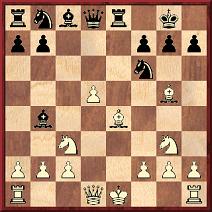
11...Nxe4 12 Bxd8 Nxc3+ 13 Qe2 Nxe2+ 14 c3 Nxg3+ 15 Kd2 Nxh1 16 Rxh1 Rxd8 17 White resigns.
The three consecutive discovered checks are interesting, but the game is fiction. As shown on page 4 of part two of the Carlsbad, 1911 tournament book, the game went 9 exd5 Bxc3+ 10 bxc3 e4 11 Bxe4 Re8 12 Ng3 Nxe4 13 Bxd8 Nxc3+ 14 Kd2 Nxd1+ 15 Ba5 Nb2, and White eventually resigned after Black’s 45th move.
Game 7 could hardly be called famous:
1 d4 f5 2 e4 fxe4 3 c4 e6 4 Nc3 Nf6 5 Bg5 Bb4 6 f3 exf3 7 Nxf3 O-O 8 Bd3 b6 9 O-O Bxc3 10 bxc3 Bb7 11 Ne5 d6 12 Ng4 Nbd7 13 Qe1 Qe8 14 Qh4 Ne4 15 Be7 Rxf1+ 16 Rxf1 d5 17 Rf3 Qg6 18 Rg3 Qe8 19 cxd5 exd5 20 Bxe4 dxe4 21 Nh6+ Kh8 22 Rxg7 Kxg7 23 Nf5+ Kg8 24 Bf6 Kf7 25 Bg5 Kg6 26 g4 Kf7 27 Qxh7+ Ke6 28 Ng7+ Kd6 29 Bf4+ Resigns.
Jaffe stated that this was ‘between J. Bernstein and Dr H. Adair played at an International Tournament in N.Y.’, but we have yet to identify the occasion. There was a game between J. Bernstein and Dr G.F. Adair at the New York tournament in July-August 1913 (an event won by Capablanca ahead of Důras), but it ended in a draw.
Game 9 was a Marshall brilliancy against ‘Elfen’ Bogoljubow, while Game 10 was an Alekhine loss (the second match game against Euwe in 1935) in which, after 1 d4 Nf6 2 c4, Jaffe gave 2…g6 a question mark.
Jaffe’s Chess Primer, all 95 roomy pages of it, is seen mercifully seldom nowadays, and a publisher may be tempted to produce a reprint of what is, after all, a classic pageant of bumptiousness, incompetence and falsehood. The Primer would certainly fit in well with the chess list of Cardoza Publishing.
***
Note: The above article first appeared as C.N. 2647.
This was the position after White’s 26th move in the game J. Corzo v C. Jaffe, Havana, 1913:

Jaffe now played 26...Qd6, and Capablanca gave the following note in his book on the event, Torneo internacional de ajedrez:
‘26...Qxb5 was without any doubt the best move, and if then 27 Rb1, see the following variation: 27 Rb1 Qa5 28 d4 (not 28 Rxb6 d4 and if 28 Qxb6 Qxc3) 28...exd4 29 cxd4 Qa2+ 30 Kh3 g5! 31 hxg6+ Nxg6 32 e5 Nxh4! 33 exf6 Nf5 34 Qf4 Rxg3+ 35 Qxg3 Nxg3 36 Kxg3 Qd2 or 36...Kg6 and Black will at least draw.’
But why not simply 33...Qg2+ 34 Kxh4 Qxg3+ 35 Kh5 Rg5+ 36 Qxg5 Qxg5 mate?
These notes are to be found on page 57 of the Cuban original of the tournament book by Capablanca (page 35 of the English translation). The translator’s only excuse would be that nobody would expect Capablanca to give a drawing variation where a mate in four is on ...
(227)
Nigel Short has been reading Capablanca’s book on the Havana, 1913 tournament and comments to us:
‘I find Capablanca’s accusations against Jaffe, and by implication Marshall, a little unbecoming. Of course, the bare game-scores do not necessarily tell the whole story, but I see nothing in the moves themselves that suggests any connivance between the two. It looks like a case of sour grapes by Capablanca, and I do not see how a 1½/2 score for Marshall against Jaffe was anything other than a fair reflexion of their difference in ability.’
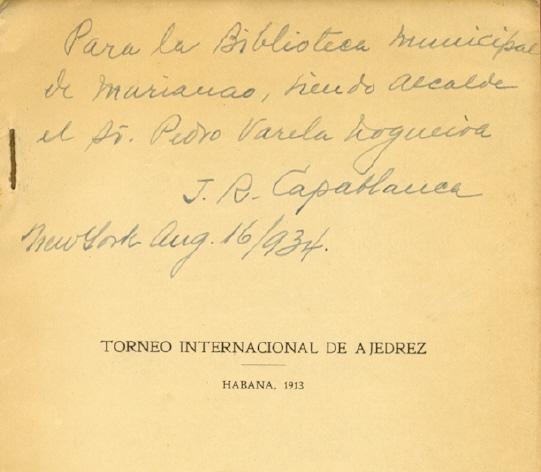
In the double-round Havana tournament Frank J. Marshall and Charles Jaffe met in rounds one and eight. The scores are given below with Capablanca’s notes:
Frank James Marshall – Charles Jaffe1 d4 d5 2 c4 e6 3 Nc3 Nf6 4 Bg5 Nbd7 5 e3 c6 6 a3 Bd6 7 Nf3 O-O 8 Qc2 dxc4 9 Bxc4 e5 10 Rd1 Qc7 11 h4 exd4 12 Nxd4 Be5 13 Ba2 Re8 14 h5 Bxd4 15 Rxd4 Qe5 16 Bxf6 Nxf6 17 Rhh4 Bf5 18 Qd2 h6 19 Qe2 Rad8 20 Rxd8 Rxd8 21 Rb4 b6 22 Qf3 c5 23 Rf4 Be6 24 Bxe6 Qxe6 25 Ne4 Nxe4 26 Qxe4 Qxe4 27 Rxe4 Kf8 28 Ke2 Rd7 29 g4 Drawn. ‘No comments have been appended to this game because the annotator is convinced that Black made no effort at all to win, and it is pointless to indicate the weakness of various moves when in fact they were played with the sole object of avoiding defeating one of the competitors.’
Charles Jaffe – Frank James Marshall1 d4 d5 2 Nf3 c5 3 dxc5 e6 4 e4 Bxc5 5 exd5 exd5 6 Bb5+ Nc6 7 O-O Nge7 8 Nbd2 O-O 9 Nb3 Bb6 10 c3 Bg4 11 Be2 Qd6 12 Nfd4 Bxe2 13 Nxe2 Ng6 14 Nbd4 Nxd4 15 Nxd4 Bxd4 16 Qxd4 Rfe8 17 Rd1 Re2 18 Rb1 Rae8 19 Be3 Ne5 20 Qxd5 Re1+ 21 Rxe1 Qxd5 22 Bd4 Re6 23 Rbd1 Rg6 24 White resigns. ‘As with the first game between these two masters, no annotations are required because it is obvious that Jaffe did not make any attempt at winning, and his blunder on the 20th move is best concealed and the game passed over.’
... The Capablanca v Jaffe feud was also discussed on page 48 of our book on the Cuban, where it was noted, inter alia, that after Havana, 1913 Capablanca and Jaffe never again met in a tournament.What more can be discovered about the dispute? In particular, can forgotten statements by any of the three masters be found?
(4642)
The Capablanca-Jaffe feud was first raised in C.N. 483, where Fred Wilson (New York, NY, USA) wrote that Capablanca believed Jaffe to have thrown a game to Marshall at Havana, 1913 and that Jaffe subsequently accused the Cuban of ruining his career by preventing him from playing in events in which Capablanca was to participate.
In C.N. 534 David Hooper (Bridport, England) responded:
‘His is merely the moan of a failure. He did play at Rye Beach, 1918 (equal third), New York, 1921 (third), New York, 1922 (second), Cedar Point, 1925 (third), Chicago, 1926 (equal fourth). But there were many other US tournaments in which he might have competed, i.e. had he so wished. In the event, he won nothing of consequence and you would need to do this to get invitations from, say Europe. Capablanca also (? from when, 1919?) would not play in tournaments with Kostić, I’m told.’
Hard facts are still being sought.
We have pointed out the difficulties in establishing firm biographical information about Charles Jaffe, and especially his date of birth. Now, Olimpiu G. Urcan (Singapore) has found the document below, dated 10 September 1937, at the Ancestry.com website:
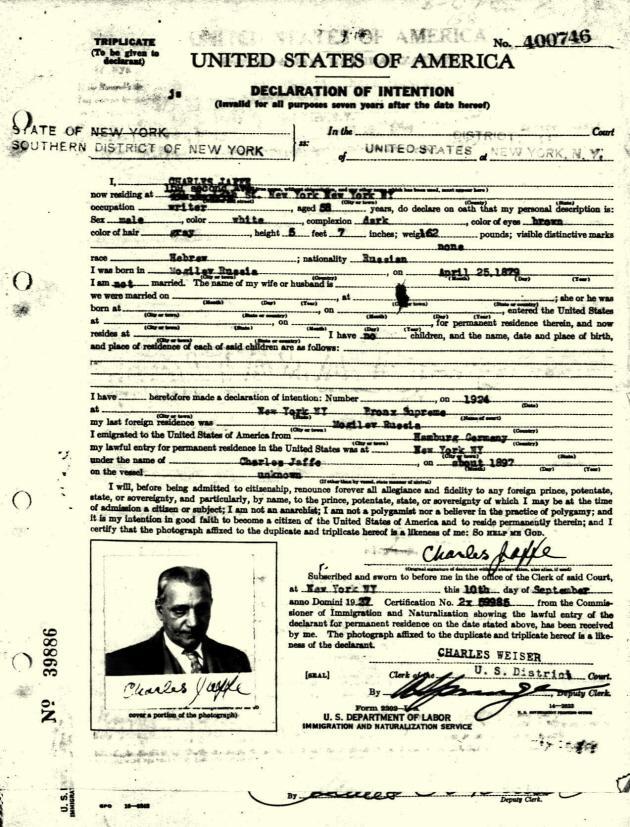
Exact reference source: Declaration of Intent (1937), National Archives; Washington, DC; Petitions for Naturalization from the US District Court for the Southern District of New York, 1897-1944; Series: M1972; Roll: 1288.
The information provided includes:
Address: 158(?) Second Avenue, New York;
Occupation: writer;
Marital status: unmarried;
Height and weight: 5 feet 7 inches; 162 pounds;
Date and place of birth: 25 April 1879 in Mogilev, Russia;
Emigrated from Hamburg to New York, circa 1897.
The picture of Jaffe in the Declaration of Intention may be compared with this detail from the group photograph (Chicago, 1937) given in C.N. 7351:
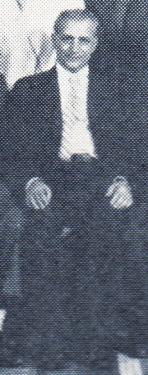
With respect to the signatures on the form, below is the inscription in our copy of Jaffe’s Chess Primer:

Mr Urcan has also found a subsequent Petition for Naturalization, which gave Jaffe’s address as 702 E. Fifth Street, New York:
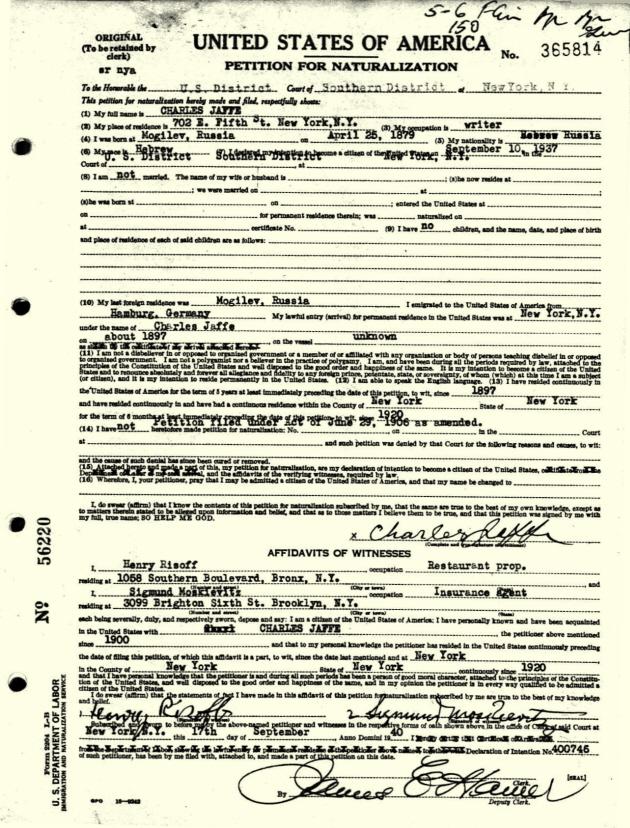
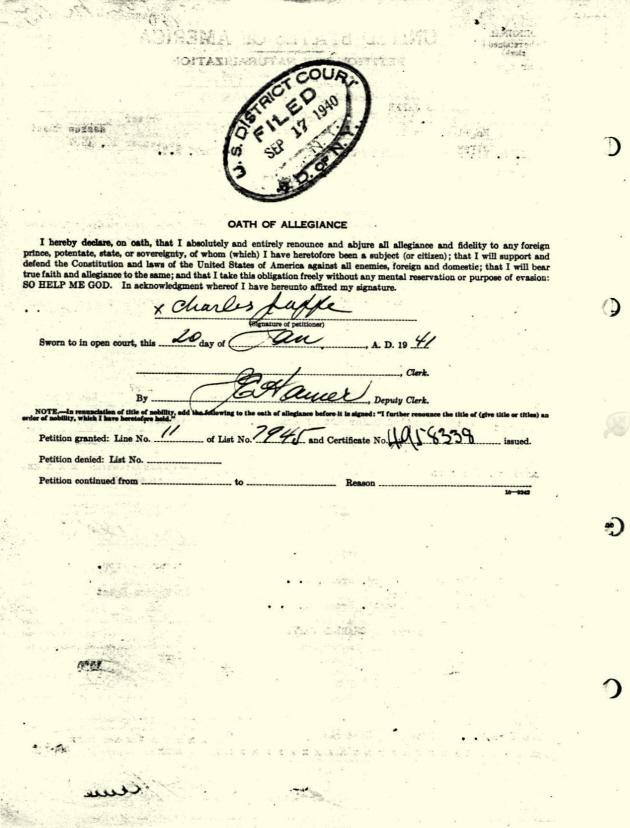
Exact reference source: National Archives; Washington, DC; Petitions for Naturalization from the US District Court for the Southern District of New York, 1897-1944; Series: M1972; Roll:1288.
(7865)
John Blackstone (Las Vegas, NV, USA) has drawn attention to this photograph on page 9 of section three of the New York Sun, 5 February 1911:
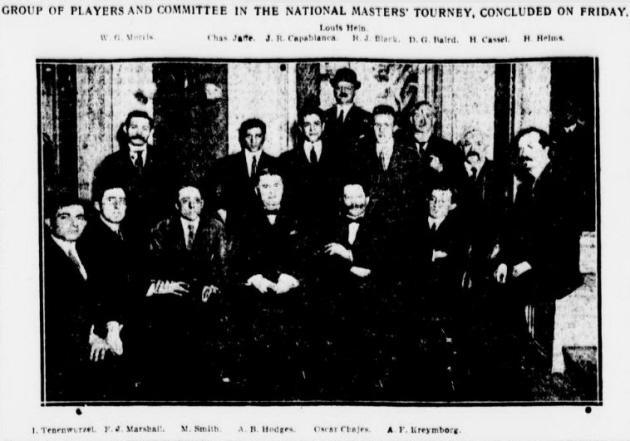
We should very much like to trace a copy of better quality.
(7871)
A late photograph of Jaffe, seated next to Frank Marshall, was published on page 79 of the May 1940 Chess Review.
Photographs of Jaffe are scarce and usually of poor quality. Below, for instance, is page 204 of the September 1909 American Chess Bulletin:
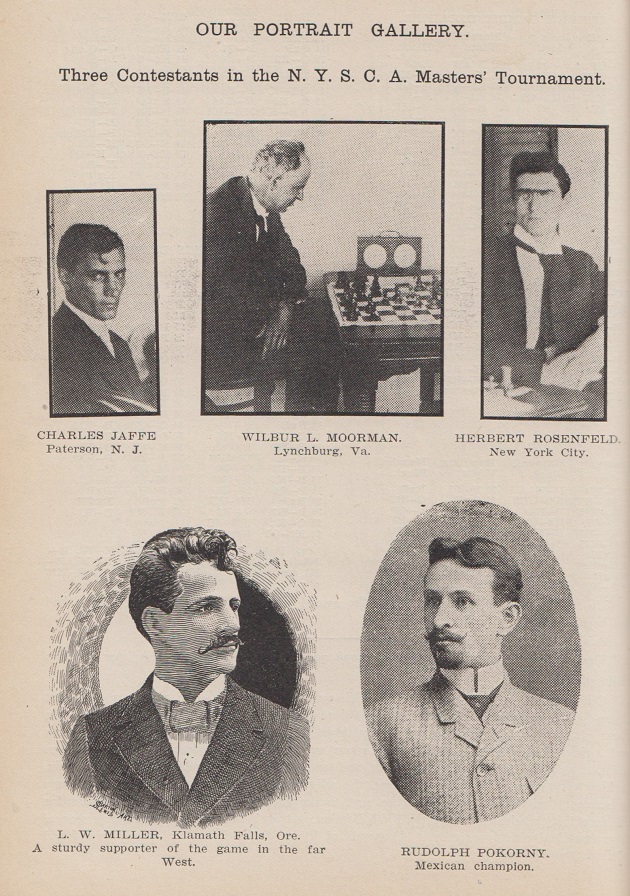
Olimpiu G. Urcan has found the following on page 15 of the Buffalo Sunday Morning News, 12 February 1911:
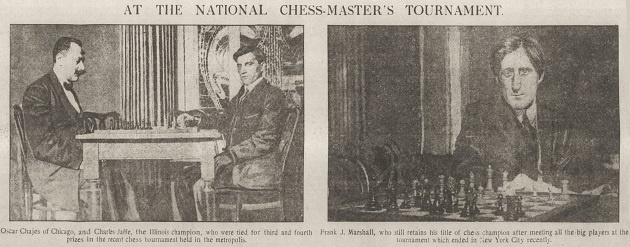
(10925)
Further newspaper cuttings received from Olimpiu G. Urcan:
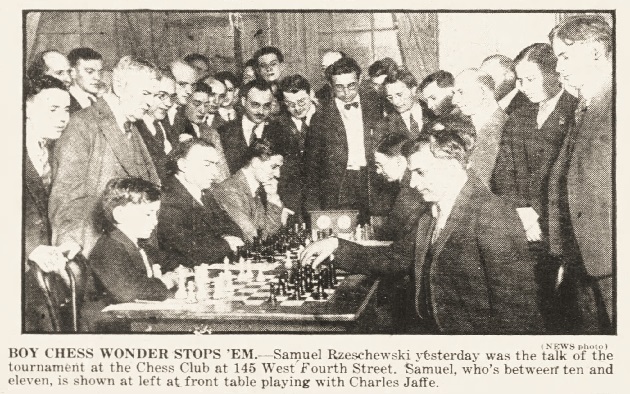
Daily News (New York), 10 October 1922, page 12
C.N. 6083 showed a later publication of this photograph (page 158 of the November 1922 American Chess Bulletin).
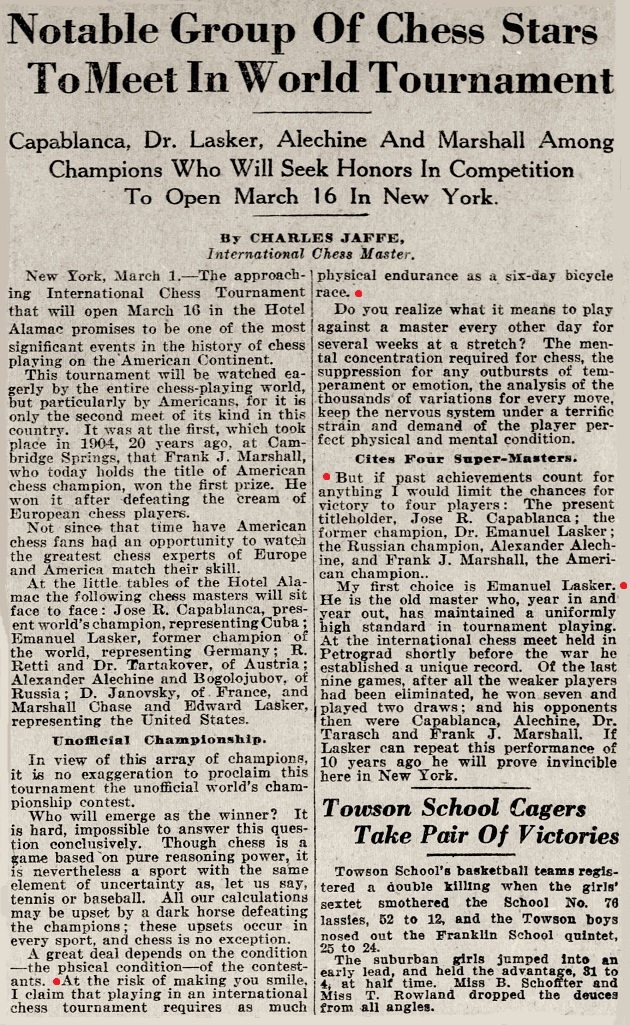
Baltimore Sun, 2 March 1924, page 4, part 1, section 2
The article is notable for the accuracy of Jaffe’s prediction about New York, 1924 and for his general remark about the arduousness of such events:
‘... playing in an international chess tournament requires as much physical endurance as a six-day bicycle race.’
(10926)
Ross Jackson (Raumati South, New Zealand) asks what is known about the claim on page 190 of The World of Chess by A. Saidy and N. Lessing (New York, 1974) that during the 1927 world championship match Jaffe sent Alekhine a cable which ‘contained an analysis of a variation of the Queen’s Gambit with a new move suggested by Jaffe, which Alekhine is thought to have adopted’.
(10674)
Page 189 of The World of Chess by A. Saidy and N. Lessing (New York, 1974) has a photograph of Jaffe in play against Lessing.
Avital Pilpel (Haifa, Israel) informs us that Moshe Roytman has found on the online database of Jewish publications in the National Library of Israel that in 1906 Charles Jaffe launched a Yiddish-language chess periodical, דער אידישער שאך-זשורנאל (‘The Jewish Chess Journal’). The second page listed the contents:
1. Foreword;
2. Recommendations for the new journal from Em. Lasker and M. Ginsburg;
3. A biography of Professor Rice;
4. Ibn Ezra’s ‘Song of Chess’;
5. Chess and how to play it (the laws of the game);
6. The opening: a brief analysis of two lines in the King’s Gambit;
7. Marshall v von Scheve (Rice Gambit game, with notes by The Field and by Jaffe);
8. The chess world. News and announcements. In particular, an obituary of Max Judd;
9. Em. Lasker v Pillsbury with notes by Jaffe;
10. Problems and endgame department.
Noting the stamp of the Cleveland Public Library on the second page, we have obtained the Library’s permission to show the full issue here as a PDF file.
To the Chess Notes main page.
To the Archives for other feature articles.
Copyright: Edward Winter. All rights reserved.